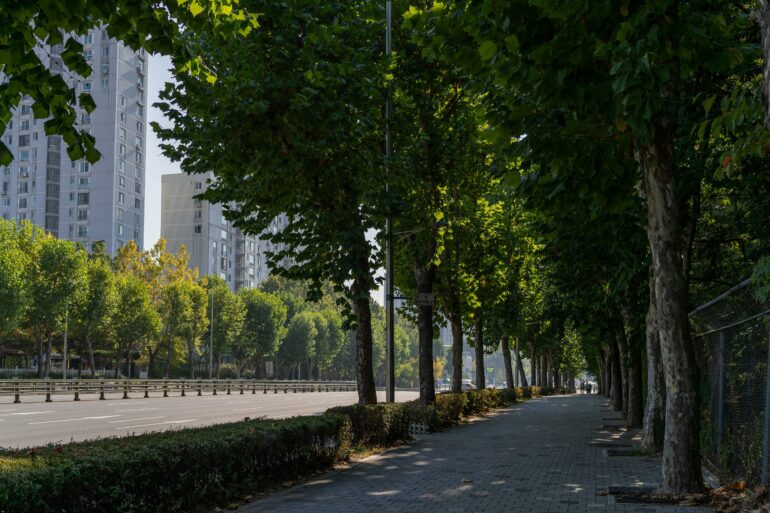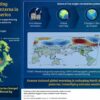Extreme heat waves, once considered rare, are now frequent and severe in cities due to climate change. Phoenix faced such a brutal heat wave in July of 2023 when it endured 31 consecutive days of high temperatures of at least 110° F. The severity of the heat wave triggered a state of emergency. In June of 2021, the town of Lytton, B.C., Canada, hit a blistering 121° F, leading to a fire that burnt most of the village.
This pattern repeated in Europe in 2022, where heat caused fatal illnesses, wildfires and damaged infrastructure, highlighting an urgent need for climate adaptation measures.
In order to make crucial urban planning decisions across the United States, city managers and stakeholders will need to better understand the outcomes of potential solutions that address the immediate impacts of heat exposure on cities and the long-term climate impacts, both individually and together.
New research published in Nature Cities examines, for the first time, the potential benefits of combining heat adaptation strategies—such as implementing cool roofs and planting street trees—with mitigation strategies—such as reducing greenhouse gas emissions—to lessen heat exposure across major U.S. cities. It also identifies the regions in which these strategies could best benefit future populations.
“Research to date has focused on the reduction of harmful impacts on cities resulting from either increased emissions of greenhouse gases or direct effects from the built environment,” said Matei Georgescu, lead author of the paper and an associate professor at Arizona State University’s School of Geographical Sciences and Urban Planning.
“Our work highlights the value of adaptation to reduce human heat exposure at the city level but then goes further to emphasize the benefits of deploying adaptation strategies in tandem with mitigation strategies.”
The paper, “Quantifying the decrease in heat exposure through adaptation and mitigation in twenty-first-century U.S. cities,” is coauthored by Ashley Broadbent of the National Institute of Water and Atmospheric Research, Wellington, New Zealand, and E. Scott Krayenhoff of the School of Environmental Sciences at the University of Guelph, Ontario, Canada.
In the study, the researchers used computer models to simulate future climate conditions that account for urban expansion, greenhouse gas emissions and population movement through the end of the century.
Then they examined the extent to which adaptation and mitigation strategies, in isolation and in tandem, can reduce population heat exposure across end-of-century U.S. cities and large urban areas.
The adaptation strategies examined included deploying cool and evaporative roofs on buildings and street trees that were applied uniformly across all cities. Mitigation strategies involved the reduction in global emissions of greenhouse gases. The simulations examined a contemporary decade (2000–2009) against future projections (2090–2099).
The study found that some cities like Tulsa, Okla., will respond better to adaptation strategies such as deploying street trees and cool roofs to cope with heat, while others like Denver benefit more from reducing greenhouse gas emissions.
When focusing on lowering emissions as a strategy to reduce the impact of heat, the study found that exposure to extreme heat for people in cities tends to be higher in southern latitude cities compared to those in northern latitudes. This pattern is seen for adaptation strategies that help us deal with the heat right now and mitigation strategies that tackle the longer-term problems of climate change.
The researchers also discovered that the effectiveness of these strategies in reducing extreme heat exposure varies throughout the day, but remains consistent during nighttime.
When simultaneously implementing adaptation and mitigation measures, the study shows the benefits are the greatest in the Northeast and Midwest regions, encompassing cities like New York, Boston and Chicago. Sun Belt cities, including Los Angeles and Miami, face more limited heat exposure reductions.
Relative increases in population heat exposure remain after implementing adaptation and mitigation measures and are limited to Southeast, Great Plains and Southwest urban areas.
“We underscore the importance of characterizing such results on the basis of individual urban environments, as it paves the way for prioritizing strategies with identified impacts at the urban, rather than broader regional or national scale,” said Georgescu who also is director of ASU’s Urban Climate Research Center. “The study helps us develop a timeline of implementation strategies to enhance livability in our cities.”
Moving forward
In the future, the researchers suggest further advancing modeling work to examine how impactful adaptation strategies can be in reducing adverse heat-related impacts by targeting specific neighborhoods within cities while facilitating collaboration between cities and academic institutions.
“Collaboration between cities and academic institutions is crucial to gather important data and develop sound policies that can effectively protect at-risk communities from the effects of climate change and the added burden of heat from the built environment,” said Georgescu.
“By understanding which strategies work best at the local level, and how such strategies may work differently depending on geographical context, we can create effective plans to tackle place-based climate challenges while continuing to work on mitigation strategies that deal with long-term consequences. Working together is key to creating better strategies for a sustainable and resilient future.”
More information:
Matei Georgescu et al, Quantifying the decrease in heat exposure through adaptation and mitigation in twenty-first-century U.S. cities, Nature Cities (2023). DOI: 10.1038/s44284-023-00001-9
Provided by
Arizona State University
Citation:
Research reveals regions in US where heat adaptation and mitigation efforts can most benefit future populations (2023, December 18)



